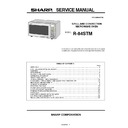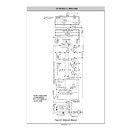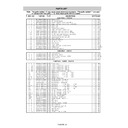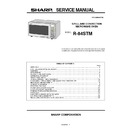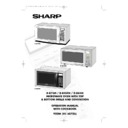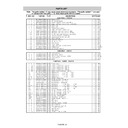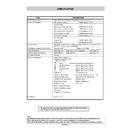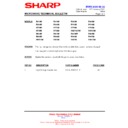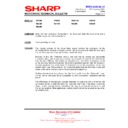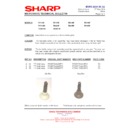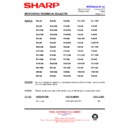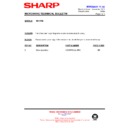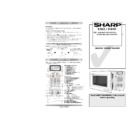Sharp R-84ST (serv.man3) Service Manual ▷ View online
R-84STM - 18
MICROWAVE MEASUREMENT
After any repair, the microwve oven must be checked
for microwave leakage to ensure continued safe
operation. BS EN 60335-2-25 specifies that the
maximum permitted leakage with a load of 275ml is 50
W/m
for microwave leakage to ensure continued safe
operation. BS EN 60335-2-25 specifies that the
maximum permitted leakage with a load of 275ml is 50
W/m
2
(equivalent to 5mW/cm
2
) at a distance of 5cm
from the oven.
PREPARATION
The following items are required to carry out this test:-
1.
1.
A low form of 600ml beaker made from
electrically non-conductive material, such as
glass or plastic, with an inside diameter of
approximately 8.5cm. This must contain 275
electrically non-conductive material, such as
glass or plastic, with an inside diameter of
approximately 8.5cm. This must contain 275
±
15ml of water, at an initial temperature of 20
±
2
°C.
2.
A leakage detector which has been calibrated
within the preceeding 12 months to a stand
whose accuracy can be traced to National
Physical Laboratory Standards.
within the preceeding 12 months to a stand
whose accuracy can be traced to National
Physical Laboratory Standards.
Recommended instruments are:
Apollo "XI"
Celtec "A1000"
Celtec "A1000"
Before commencing the test, check the leakage
detector is functioning and adjusted according to the
manufacturer's instructions, and any spacers are fitted
to ensure that measurement is taken 5cm from the
surface of the oven.
detector is functioning and adjusted according to the
manufacturer's instructions, and any spacers are fitted
to ensure that measurement is taken 5cm from the
surface of the oven.
Dotted line indicaes path taken by the leakage detector
Whilst the maximum leakage permitted in BS EN 60335-2-25 is 50 W/m
2
(equivalent to 5mW/cm
2
), it is not
normal to detect anything signifcant, and therefore any detected leakage should be investigated.
PROCEDURE
1.
Place the beaker containing the water load
inthe oven cavity at the centre of the
turntable. The placing of this standard load in
the oven is important, not only to protect the
oven, but also to ensure that any leakage it is
not disguised by too large a load absorbing
the energy.
inthe oven cavity at the centre of the
turntable. The placing of this standard load in
the oven is important, not only to protect the
oven, but also to ensure that any leakage it is
not disguised by too large a load absorbing
the energy.
2.
Close the oven door, and with the power level
set to FULL, turn the oven ON with the timer
set for a few minutes operation. Should the
water begin to boil before the test has benn
completed, it should be replaced.
set to FULL, turn the oven ON with the timer
set for a few minutes operation. Should the
water begin to boil before the test has benn
completed, it should be replaced.
3.
As shown in the diagram below, move the
probe slowly (not faster than 2.5cm/sec);-
probe slowly (not faster than 2.5cm/sec);-
a)
around the edge of the door following the gap
b)
across the face of the door
c)
across any vents in the oven's sides, rear or
top
top
R-84STM - 18
MICROWAVE MEASUREMENT
After any repair, the microwve oven must be checked
for microwave leakage to ensure continued safe
operation. BS EN 60335-2-25 specifies that the
maximum permitted leakage with a load of 275ml is 50
W/m
for microwave leakage to ensure continued safe
operation. BS EN 60335-2-25 specifies that the
maximum permitted leakage with a load of 275ml is 50
W/m
2
(equivalent to 5mW/cm
2
) at a distance of 5cm
from the oven.
PREPARATION
The following items are required to carry out this test:-
1.
1.
A low form of 600ml beaker made from
electrically non-conductive material, such as
glass or plastic, with an inside diameter of
approximately 8.5cm. This must contain 275
electrically non-conductive material, such as
glass or plastic, with an inside diameter of
approximately 8.5cm. This must contain 275
±
15ml of water, at an initial temperature of 20
±
2
°C.
2.
A leakage detector which has been calibrated
within the preceeding 12 months to a stand
whose accuracy can be traced to National
Physical Laboratory Standards.
within the preceeding 12 months to a stand
whose accuracy can be traced to National
Physical Laboratory Standards.
Recommended instruments are:
Apollo "XI"
Celtec "A1000"
Celtec "A1000"
Before commencing the test, check the leakage
detector is functioning and adjusted according to the
manufacturer's instructions, and any spacers are fitted
to ensure that measurement is taken 5cm from the
surface of the oven.
detector is functioning and adjusted according to the
manufacturer's instructions, and any spacers are fitted
to ensure that measurement is taken 5cm from the
surface of the oven.
Dotted line indicaes path taken by the leakage detector
Whilst the maximum leakage permitted in BS EN 60335-2-25 is 50 W/m
2
(equivalent to 5mW/cm
2
), it is not
normal to detect anything signifcant, and therefore any detected leakage should be investigated.
PROCEDURE
1.
Place the beaker containing the water load
inthe oven cavity at the centre of the
turntable. The placing of this standard load in
the oven is important, not only to protect the
oven, but also to ensure that any leakage it is
not disguised by too large a load absorbing
the energy.
inthe oven cavity at the centre of the
turntable. The placing of this standard load in
the oven is important, not only to protect the
oven, but also to ensure that any leakage it is
not disguised by too large a load absorbing
the energy.
2.
Close the oven door, and with the power level
set to FULL, turn the oven ON with the timer
set for a few minutes operation. Should the
water begin to boil before the test has benn
completed, it should be replaced.
set to FULL, turn the oven ON with the timer
set for a few minutes operation. Should the
water begin to boil before the test has benn
completed, it should be replaced.
3.
As shown in the diagram below, move the
probe slowly (not faster than 2.5cm/sec);-
probe slowly (not faster than 2.5cm/sec);-
a)
around the edge of the door following the gap
b)
across the face of the door
c)
across any vents in the oven's sides, rear or
top
top
R-84STM - 18
MICROWAVE MEASUREMENT
After any repair, the microwve oven must be checked
for microwave leakage to ensure continued safe
operation. BS EN 60335-2-25 specifies that the
maximum permitted leakage with a load of 275ml is 50
W/m
for microwave leakage to ensure continued safe
operation. BS EN 60335-2-25 specifies that the
maximum permitted leakage with a load of 275ml is 50
W/m
2
(equivalent to 5mW/cm
2
) at a distance of 5cm
from the oven.
PREPARATION
The following items are required to carry out this test:-
1.
1.
A low form of 600ml beaker made from
electrically non-conductive material, such as
glass or plastic, with an inside diameter of
approximately 8.5cm. This must contain 275
electrically non-conductive material, such as
glass or plastic, with an inside diameter of
approximately 8.5cm. This must contain 275
±
15ml of water, at an initial temperature of 20
±
2
°C.
2.
A leakage detector which has been calibrated
within the preceeding 12 months to a stand
whose accuracy can be traced to National
Physical Laboratory Standards.
within the preceeding 12 months to a stand
whose accuracy can be traced to National
Physical Laboratory Standards.
Recommended instruments are:
Apollo "XI"
Celtec "A1000"
Celtec "A1000"
Before commencing the test, check the leakage
detector is functioning and adjusted according to the
manufacturer's instructions, and any spacers are fitted
to ensure that measurement is taken 5cm from the
surface of the oven.
detector is functioning and adjusted according to the
manufacturer's instructions, and any spacers are fitted
to ensure that measurement is taken 5cm from the
surface of the oven.
Dotted line indicaes path taken by the leakage detector
Whilst the maximum leakage permitted in BS EN 60335-2-25 is 50 W/m
2
(equivalent to 5mW/cm
2
), it is not
normal to detect anything signifcant, and therefore any detected leakage should be investigated.
PROCEDURE
1.
Place the beaker containing the water load
inthe oven cavity at the centre of the
turntable. The placing of this standard load in
the oven is important, not only to protect the
oven, but also to ensure that any leakage it is
not disguised by too large a load absorbing
the energy.
inthe oven cavity at the centre of the
turntable. The placing of this standard load in
the oven is important, not only to protect the
oven, but also to ensure that any leakage it is
not disguised by too large a load absorbing
the energy.
2.
Close the oven door, and with the power level
set to FULL, turn the oven ON with the timer
set for a few minutes operation. Should the
water begin to boil before the test has benn
completed, it should be replaced.
set to FULL, turn the oven ON with the timer
set for a few minutes operation. Should the
water begin to boil before the test has benn
completed, it should be replaced.
3.
As shown in the diagram below, move the
probe slowly (not faster than 2.5cm/sec);-
probe slowly (not faster than 2.5cm/sec);-
a)
around the edge of the door following the gap
b)
across the face of the door
c)
across any vents in the oven's sides, rear or
top
top
R-84STM - 18
MICROWAVE MEASUREMENT
After any repair, the microwve oven must be checked
for microwave leakage to ensure continued safe
operation. BS EN 60335-2-25 specifies that the
maximum permitted leakage with a load of 275ml is 50
W/m
for microwave leakage to ensure continued safe
operation. BS EN 60335-2-25 specifies that the
maximum permitted leakage with a load of 275ml is 50
W/m
2
(equivalent to 5mW/cm
2
) at a distance of 5cm
from the oven.
PREPARATION
The following items are required to carry out this test:-
1.
1.
A low form of 600ml beaker made from
electrically non-conductive material, such as
glass or plastic, with an inside diameter of
approximately 8.5cm. This must contain 275
electrically non-conductive material, such as
glass or plastic, with an inside diameter of
approximately 8.5cm. This must contain 275
±
15ml of water, at an initial temperature of 20
±
2
°C.
2.
A leakage detector which has been calibrated
within the preceeding 12 months to a stand
whose accuracy can be traced to National
Physical Laboratory Standards.
within the preceeding 12 months to a stand
whose accuracy can be traced to National
Physical Laboratory Standards.
Recommended instruments are:
Apollo "XI"
Celtec "A1000"
Celtec "A1000"
Before commencing the test, check the leakage
detector is functioning and adjusted according to the
manufacturer's instructions, and any spacers are fitted
to ensure that measurement is taken 5cm from the
surface of the oven.
detector is functioning and adjusted according to the
manufacturer's instructions, and any spacers are fitted
to ensure that measurement is taken 5cm from the
surface of the oven.
Dotted line indicaes path taken by the leakage detector
Whilst the maximum leakage permitted in BS EN 60335-2-25 is 50 W/m
2
(equivalent to 5mW/cm
2
), it is not
normal to detect anything signifcant, and therefore any detected leakage should be investigated.
PROCEDURE
1.
Place the beaker containing the water load
inthe oven cavity at the centre of the
turntable. The placing of this standard load in
the oven is important, not only to protect the
oven, but also to ensure that any leakage it is
not disguised by too large a load absorbing
the energy.
inthe oven cavity at the centre of the
turntable. The placing of this standard load in
the oven is important, not only to protect the
oven, but also to ensure that any leakage it is
not disguised by too large a load absorbing
the energy.
2.
Close the oven door, and with the power level
set to FULL, turn the oven ON with the timer
set for a few minutes operation. Should the
water begin to boil before the test has benn
completed, it should be replaced.
set to FULL, turn the oven ON with the timer
set for a few minutes operation. Should the
water begin to boil before the test has benn
completed, it should be replaced.
3.
As shown in the diagram below, move the
probe slowly (not faster than 2.5cm/sec);-
probe slowly (not faster than 2.5cm/sec);-
a)
around the edge of the door following the gap
b)
across the face of the door
c)
across any vents in the oven's sides, rear or
top
top

